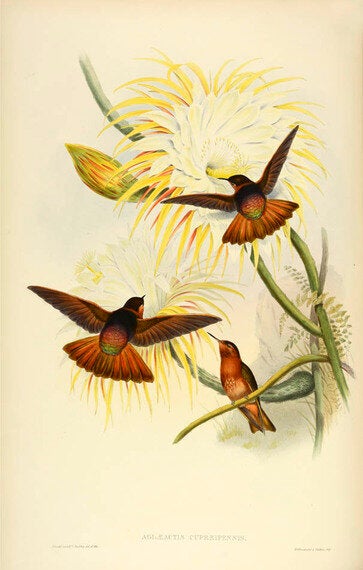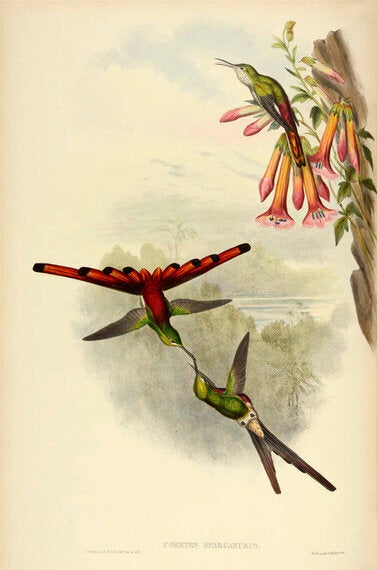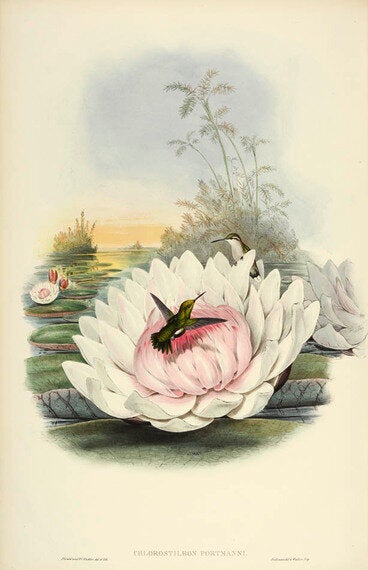I have just come across one of the saddest, most extraordinary obsessions ever to sweep Britain: for a few decades, Victorian Brits went completely mad for all things hummingbird.
I'd vaguely heard about the hummingbird craze, but until a week ago, I knew very little about it.

And then I happened to mooch into a second-hand book shop - though they'd probably recoil at being described as a "second-hand book shop". No matter - I love second-hand books, and Shapero's Books has tons of them. Thousands of them. Though they call them "rare" rather than second-hand; I guess the difference between Shapero's books and the ones in my local Oxfam is about three zeroes on the end of the price.
But the books in Shapero's are just eye-popping. You can feel the history on the shelves - not just first editions, but first editions owned by amazing people. I drooled.
And such splendid words they have to describe them too. How about "Incunable"? I'd never heard that one before. It means "from the cradle", describes any book before 1500.
Shapero's specialise in travel and natural history, though of late, they've just started up a Russian section - the perfect place to buy a gift for your friendly local oligarch.
Anyway - let's get back to the hummingbirds, because Shapero's has somehow managed to get a complete collection of John Gould's bird books. It's the ornithological Bible - yours for £1.5 Million.

Gould was crazy about birds and spent most of his life either painting or collecting them. These paintings - well over 3,000 of them - were put together into 44 folio volumes. I have had these books in my hands. They are vast, as long as your arm and quite heavy. It took over five decades to print them all; this was a man on a mission.
Gould spent his life travelling the world gathering and painting birds, and his favourites by far were the hummingbirds. It would be fair to say that Gould was utterly obsessed with them - when he died in 1881 at the age of 76, he owned over 5,000 hummingbirds, all of them stuffed.

The birds were big business. In one week in 1888, some 400,000 hummingbird skins went under the hammer.
Gould was the main ring-master of this fashion. During the Great Exhibition in 1851, Gould put on a show of stuffed hummingbirds which attracted over 75,000 visitors and netted him £800.
Queen Victoria, who saw the hummingbirds with Prince Albert, put the seal on the craze by saying: "It is the most beautiful and complete collection ever seen, and it is impossible to imagine anything so lovely as these little Humming Birds, their variety, and extraordinary brilliancy of their colours."
Hmmm... don't you love the way she says it's "impossible to imagine anything so lovely"? Well... you should try seeing these birds, live and actually flying in the air.
Gould, meanwhile, seems equally blinkered. He describes an attempt to ship two hummingbirds back home to Britain; it did not end well.
I'll quote him in full:
"The specimens I brought alive to this country were as docile and fearless as a giant moth or any other insect would be under similar treatment. The little cage in which they lived was twelve inches long by seven inches wide and eight inches high.
"In this was placed a diminutive twig of a tree and suspended to the side a glass phial which I duly supplied with saccharine matter in the form of sugar or honey and water with the addition of the yolk of an unboiled egg.
"Upon this food they appeared to thrive and be happy during the voyage along the sea-board of America and across the Atlantic until they arrived within the influence of the climate of Europe.
"Off the Western part of Ireland, symptoms of drooping unmistakably exhibited themselves; but although they never fully rallied I, as before stated, succeeded in bringing one of them alive to London where it died on the second day after its arrival in my house."
Oh dear.

Today, of course, it does all seem barbaric. But Gould's desire to collect these beautiful birds, dead or alive, was very much of its era. Charles Darwin was equally keen on killing birds when he was out sailing the Pacific.
Heaven knows what happened to Gould's immense collection of stuffed hummingbirds; I guess a lot of these birds must now be extinct.
But his amazing pictures, many of which were hand-coloured by his wife Elizabeth and by his friend the poet Edward Lear, will live on in these folios for a long time yet.
You can catch Gould's books at the Masterpiece Fair, London, from June 26 to July 2.
